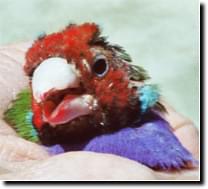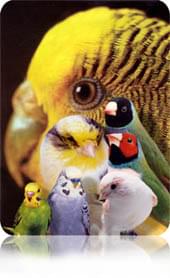
Gouldians & Canaries
Wheezing, clicking, sneezing, coughing, open mouth breathing,
tail bobbing, nasal discharge, and excessive beak wiping are all signs of the
 Air Sac Mites
Air Sac Mites
Air-sac mite
Articles and Information - Lady Gouldian Finch
The air-sac mite does not have to mean death to your bird. Learning about the mite and the medications to treat for them, you will not lose your bird to this killer.
I had been raising Gouldians for two years when an experienced breeder came to my home to purchase my Gouldians. He asked me if he could catch the bird from the cage. After making the bird fly several times around the cage he caught it and held it to his ear. After his third catch, he announced that my birds had air sac mites. I had absolutely no idea what he was talking about. He proceeded to explain it to me and has since become my best bird breeder buddy. By learning about air- sac mites and how to treat them, you will not lose your birds to this killer.
 Air Sac Mites - Photo Collage of small birds Air Sac Mites - Photo Collage of small birds | How could my bird have the air sac mite?
- The mite is transmitted direct from the nasal cavity of an infected bird to the nasal cavity of a recipient bird via the external nostrils of each bird.
- Parents feeding food to their young.
- Courtship feeding between adults.
- Contaminated water and free living mites in the environment.
The mite crawls onto the head of a perched bird, enters the trachea, travels to the lungs and lays its eggs.
|
Avian respiratory system
A bird's respiratory system is composed of a set of lungs and 9 air-sacs. These 9 air-sacs allow for the high metabolic rate found in birds. These 9 air sacs have very thin walls with few blood vessels. Since the respiratory system helps maintain their body temperature, when it is infested with air- sac mites, birds become fluffed-up. A fluffed-up bird is trying to conserve body heat. It takes a lot of energy for a bird to maintain its high and constant body temperature, energy a sick bird doesn't have. This is why supplemental heat is so important. When you witness this behavior, place the bird in a small cage (hospital cage) with supplemental heating such as an Infrared Heat Lamp or a 60 watt bulb place near a perch. Leave that heat lamp on all night. Birds will tuck their heads to sleep. Heat will do wonders.
Birds most affected
Extensive research has been conducted on the air sac mite in finches. These studies have found air sac mites in Gouldians and 6 other species living in close proximity. The others were Budgerigars, Double-Barred (Owl) Finches, Zebra Finches, Pictorella Manikins, Masked Grassfinches and Long-Tailed Finches. The Gouldian and the Pictorella Manikins were found to be the most affected by the mite.
Air-sac mite life cycle
Air-sac mites live in the respiratory tract (trachea, air-sacs, bronchi and lungs) of birds. The female lays eggs in the lungs, eggs hatch to become nymphs and then adults. Females move to the air-sacs while the males remain in the lungs to mature. The females tend to occupy the air-sacs, nasal cavity and trachea and move to the lungs to lay their eggs. Adult males remain mostly in the lungs. The life cycle may be completed within 6 days. For more information on the air-sac mite.
Reoccurring infections from dormant mites
Once the bird is infected it is almost impossible to completely eradicate the mite. The nymph stage does not always mature immediately. Often it remains in dormancy within the respiratory tract for extended periods of time. Because the 9 air sacs have very thin walls with little blood flow, making it impossible for Ivermectin and Moxidectin, the two insecticides available to kill the air-sac mite through the blood, cause no harm to the nymph stage. These immature forms become active when the bird is ill, stressed or during hot weather. The problem can appear suddenly and spread throughout the flock quickly. Regular scheduled treatments of Ivermectin or moxidectin should be maintained to keep the adult number of mites under control. Large numbers of adult air-sac mites killed off at the same time may cause a blockage in the respiratory tract, which can cause suffocation.
Mite Damage
Once inside the bird's respiratory system the mite causes inflammation, hemorrhaging and lesions, leading to pneumonia and ultimately death if not treated. The air sac mites attach themselves by embedding their legs into connective tissue. A mucus coat secreted by the bird's immune system covers over most of the mites. Mites in the trachea plus the mucus reduce the internal volume of the trachea, affecting the ability of the birds to breathe. As the mite infestation grows, the trachea narrows even further and the bird will begin breathing with an open beak in an attempt to bring more air into the lungs. The harder it becomes for the bird to breathe the more body movement you will notice. This explains why "tail bobbing" is often stated as a symptom of the mite infection.
Note: The air-sac mite has also been found in water, on perches and in food. For this reason the nests, cage and aviary must be cleaned and disinfected with a pyrethrum-based product. | | |
Not all birds are affected
In the wild infection rate has been measured at 63% in the Gouldian. When a bird has adequate nutrition from birth, it allows the bird to develop a strong immune system. If a few mites enter the bird's respiratory system, the immune system will keep their numbers low, preventing a life threatening infestation.
Air-Sac Mite Treatment
Two Safe Treatments for the air-sac mite
There are two terrific products designed for avian use: Ivermectin or Moxidectin
Large flocks treatment with Moxidectin or Ivermectin in their drinking water.
If you have a hard time catching your birds or the total number makes it impossible for you to treat with Topicals, we offer water soluble Moxidectin and Ivermectin for treatments in the drinking water."
SCATT air - sac treatment
The active ingredient is Moxidectin. This drug kills the mite by interfering with the transmission of nerve impulses in the mite causing its paralysis and death. Birds, like mammals, do not have the same nerve transmission system as mites so the drug is harmless to them. Since SCATT remains in the bird's blood stream for up to 3 weeks, the manufacturer recommends for best results to re-treat 3 to 4 times per year, prior to and immediately after both the breeding and molting season. Ivermectin can also be applied topically but needs to be used two days a week for three weeks. This takes alot more time. Buy Scatt here
Death may occur
Unfortunately, treatment is not always as rewarding as we would like it to be. Some heavily air-sac mite infested birds can die two to seven days after treatment due to asphyxiation, resulting from the accumulation of dead mites obstructing the air.
Buy Scatt here Scaly Face and Leg Mites
Treatment for Scaly Face & Leg Mite
The scaly face mite (Knemidokoptespilae) is found primarily in Parakeets (Budgerigars), though it can turn up in canaries and finches as well. They develop a honeycomb appearance when they burrow around the face (Budgerigars) and a tassel like appearance when they burrow on the feet and legs (Canaries). The mite is found on either side of the corner of the beak and the legs and feet. This mite lives in the "DEAD" beak or leg scales. They burrow down to feed on the blood. It is very difficult to get the medication down into the infected areas. Treatment with Ivermectin and Moxidectin may take 6-8 weeks to clear up the scaly mite.
Avimec a topical Ivermectin solution can be Applied undiluted directly to the affected skin using a Q-tip one day each week for 6-8 weeks until sores heal. Take care when working on the beak area not to get any liquid into the bird's eyes or nostrils. The same day each week administer in the drinking water. Keep it away from eyes & nostrils.
Treatment with Scatt
Apply a drop of SCATT for 30 grams of body weight, to the upper part of the thigh one time and then again 3 weeks later. After applying the drop, place several drops onto a Q-tip and gently wipe it across the affected area. Take care when working on the beak not to get any liquid into the bird's eyes & nostrils. Each week thereafter apply the SCATT liquid only to the affected area using the Q-tip method.
NOT ALL TAIL BOBBING IS ASM - If after 48 hrs, there is no improvement, it may not be air sac mites? Pain causes tail bobbing so... it could be parasites or bacterial infection. If no improvement I turn the bird over, and check its stomach for intestinal parasties. If I see them I start Ronivet 12% and Trimethoprim sulfa mixed together in drinking water for two weeks. I then recheck to see if longer is needed.
Legal Disclaimer..
Terri's Glamorous Gouldians is not licensed to provide veterinary services. Nothing contained in the site is intended to replace the services of a licensed, trained physician or health professional or to be a substitute for medical advice of a veterinarian or trained veterinary professional.
© lady gouldian finch.com 2017